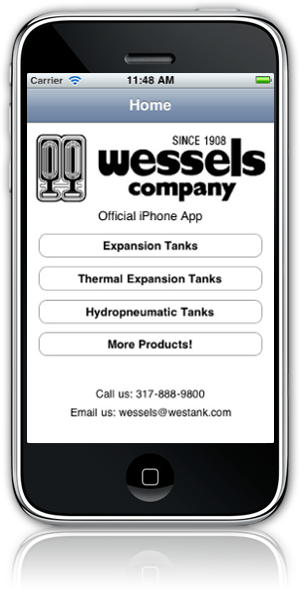Thermal Expansion Tanks
Thermal expansion tanks are designed for pressure control in a potable water system. The building's water heater or water heating system typically creates the thermally expanded water. A properly sized thermal expansion tank will accommodate this additional volume of water created through expansion during the heating cycle, and control the system pressure increases, keeping pressures from reaching critical limits. The tank uses compressed air to maintain system pressures by accepting and expelling the changing volume of water as it heats and cools. These tanks are designed utilizing a flexing butyl barrier that separates the stored water from the captured pressure control air cushion. This barrier, a replaceable bladder or fixed diaphragm, allows the water to be contained within the bladder preventing corrosion and potential water logging. The thermal expansion tanks are engineered to meet ASME standards, and are also available in non-code designs. Wessels' thermal expansion tanks are offered in industry's broadest range from 2 to 4,000 gallons and up to 250 psi.
Pressurized thermal expansion tanks differ from plain steel expansion tanks in that a flexible bladder or diaphragm separates the air cushion from the system fluid. The air side pre-charge of the tank must be field adjusted to equal the system supply pressure. As the system water expands, the bladder expands open, pushing against the air cushion to accept the expanded water.
Thermal Expansion Tank Styles
Bladder Tanks
TXA Series (ASME)
The TXA Series bladder style tanks boast many advantages over other style thermal expansion tanks. The bladder can be easily replaced in the field. The free standing models have a system connection at the bottom of the tank. This is subtle but important difference from the top connection type of tank offered by some manufactures. The TXA tank is designed to prevent any harmful build-up of dirt, grit or system contaminants in addition to providing for easy draining to assist in establishing proper air charge.
TX Series (Non-ASME)
The TX Series tanks are designed for use in low pressure residential systems and in light commercial systems where ASME construction is not required. This is a replaceable bladder tank, ranging in capacity from 2.1 gallons to 79.2 gallons, full acceptance volume. TX tanks are factory pre-charged to 40 psig (field adjustable) and are rated for 200°F operation.
Diaphragm Tanks
TTA Series (ASME)
TTA Series tanks are actually a tank within a tank. A non-ASME bladder tank is placed in an ASME tank. The bladder cannot expand any larger than the inner tank that contains it. This is why the acceptance volume of the TTA tanks is less than the total tank volume. The bladder is fixed and cannot be replaced. TTA tanks are generally less costly than the comparable TXA tank.
T Series (Non-ASME)
The T Series thermal expansion tanks are designed using a heavy-duty fixed butyl diaphragm, and are offered in sizes ranging from 2 to 132 gallons.
Skip to Primary Site Navigation, Secondary Site Navigation, Company Address, Top of Page




